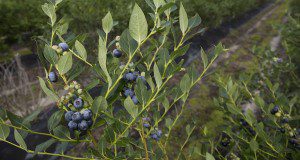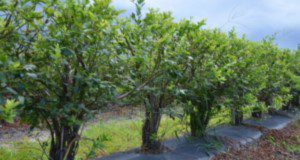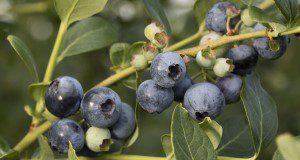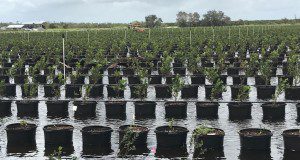Southern highbush blueberries (SHB) are commercially grown throughout Florida in both deciduous and evergreen systems. This calendar addresses general management requirements on a monthly basis for conventional (nonorganic) systems and should be used in coordination with other UF/IFAS EDIS publications. This new 7-page article, published by the UF/IFAS Horticultural Sciences Department, was written by Douglas A. Phillips, Jeffrey G. Williamson, Philip F. Harmon, Oscar E. Liburd, and Peter J. Dittmar.
https://edis.ifas.ufl.edu/hs1363
Tag: Jeffrey G. Williamson
Evergreen Production System for Southern Highbush Blueberries in Florida
In central and south-central Florida, many southern highbush blueberries (SHB) are grown in an evergreen system, in which the plants do not go dormant, and are managed to retain their leaves from the previous year through harvest the following spring to support early flowering and fruit set. The evergreen system has also been used under tunnels in north-central Florida. This new 3-page publication of the UF/IFAS Horticultural Sciences Department, written by Douglas A. Phillips, Jeffrey G. Williamson, and Patricio R. Munoz, provides an overview of the evergreen production system for SHB in Florida.
https://edis.ifas.ufl.edu/hs1362
Pruning Southern Highbush Blueberry in Florida
Pruning is an essential part of blueberry production and is used to help establish new plantings; promote postharvest growth of new foliage and fruiting wood; balance vegetative and reproductive growth; reduce disease and certain insect pressure; assist in harvesting efficiency; and promote new cane growth and plant longevity. This new 3-page publication of the UF/IFAS Horticultural Sciences Department is a discussion of pruning practices on southern highbush blueberry in Florida. Written by Douglas A. Phillips and Jeffrey G. Williamson.
https://edis.ifas.ufl.edu/hs1359
Nutrition and Fertilization Practices for Southern Highbush Blueberry in Florida
Research and field experience have demonstrated that fertilization is necessary to achieve proper growth and high yields in cultivated production of blueberries. This new 7-page publication of the UF/IFAS Horticultural Sciences Department provides guidance and management suggestions to Florida growers of southern highbush blueberry (SHB) for monitoring, supplying, and maintaining proper plant nutrition in commercial production operations. Written by Doug Phillips and Jeffrey G. Williamson.
https://edis.ifas.ufl.edu/hs1356
Impacts of Hurricane Damage on Southern Highbush Blueberries
Florida has been affected by eight hurricanes since 2000. This new 3-page publication discusses the types of hurricane damage that occur in blueberry production operations, the impacts of these damages, and some recommendations on best management practices in the aftermath of a storm. Written by Douglas A. Phillips, Jeffrey G. Williamson, and Philip F. Harmon and published by the UF/IFAS Horticultural Sciences Department.
https://edis.ifas.ufl.edu/hs1342
Establishment and Production Costs for Southern Highbush Blueberry Orchards in Florida: Enterprise Budget and Profitability Analysis
The United States is the world’s largest producer of blueberries. Florida’s blueberry production represents a small fraction of total US production, but blueberries are nevertheless an important and valuable crop in the state because Florida growers benefit from the nation’s earliest market window. In fact, the average price for blueberries received by growers in Florida during the last three years was 2.5 times the US average.
This 15-page fact sheet written by Ariel Singerman, Marina Burani-Arouca, Jeffrey G. Williamson, and Gary K. England, and published by the UF Department of Food and Resource Economics provides a summary of the enterprise budget developed for highbush blueberry production in Florida. The budget represents a typical operation and serves as an economic benchmark for growers, providing estimates of expenses and potential estimates of revenue and profit for a blueberry crop to help current and potential blueberry growers make informed decisions about blueberry production.
http://edis.ifas.ufl.edu/fe1002
2016 Florida Blueberry Integrated Pest Management Guide
This 37-page fact sheet provides extensive information about integrated pest management for growing blueberry plants in Florida. Writteny by Jeffrey G. Williamson, Philip F. Harmon, Oscar E. Liburd, and Peter Dittmar and published by the Horticultural Sciences Department.
http://edis.ifas.ufl.edu/hs380
Southern Highbush Blueberry Cultivars from the University of Florida
 Many improved southern highbush cultivars have been developed by the University of Florida breeding program since the initial releases of ‘Sharpblue’, ‘Flordablue’, and ‘Avonblue’ in the mid-1970s. Today there are more blueberry cultivar choices available for Florida growers than ever before, but in every case, cultivar selection involves weighing the advantages and disadvantages of a cultivar relative to the grower’s needs. Unfortunately, there are no perfect cultivars suited for every location and management system. This 10-page fact sheet categorizes southern highbush cultivars into four groups: major cultivars, secondary cultivars, new options, and historical cultivars. Proper cultivar selection is critical to a successful blueberry enterprise, and growers should seek information from multiple sources, including their local county Extension office. Written by J.G. Williamson, J.W. Olmstead, G.K. England, and P.M. Lyrene, and published by the UF Department of Horticultural Sciences, April 2014.
Many improved southern highbush cultivars have been developed by the University of Florida breeding program since the initial releases of ‘Sharpblue’, ‘Flordablue’, and ‘Avonblue’ in the mid-1970s. Today there are more blueberry cultivar choices available for Florida growers than ever before, but in every case, cultivar selection involves weighing the advantages and disadvantages of a cultivar relative to the grower’s needs. Unfortunately, there are no perfect cultivars suited for every location and management system. This 10-page fact sheet categorizes southern highbush cultivars into four groups: major cultivars, secondary cultivars, new options, and historical cultivars. Proper cultivar selection is critical to a successful blueberry enterprise, and growers should seek information from multiple sources, including their local county Extension office. Written by J.G. Williamson, J.W. Olmstead, G.K. England, and P.M. Lyrene, and published by the UF Department of Horticultural Sciences, April 2014.
http://edis.ifas.ufl.edu/hs1245
What is urea-triazone nitrogen?
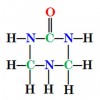 Foliar application of nitrogen and other nutrients essential for plant growth and development is an important practice for crop production. Most foliar nutrient N products contained the traditional N sources such as ammonium, nitrate and/or urea before urea-triazone N was available on the market. The traditional N sources have a greater salt index and leaf-burn potential than urea-triazone N. To avoid or minimize leaf burning, urea-triazone N fertilizers can be used instead of the traditional N sources. But growers have concerns about the safety of using triazone N fertilizers for commercial crop production because the fertilizers are still new to them. This 2-page fact sheet provides basic information on urea-triazone-based fertilizer for county faculty, crop consultants and advisors, growers, and students interested in commercial crop production. Written by Guodong Liu and Jeffrey Williamson, and published by the UF Department of Horticultural Sciences, October 2013.
Foliar application of nitrogen and other nutrients essential for plant growth and development is an important practice for crop production. Most foliar nutrient N products contained the traditional N sources such as ammonium, nitrate and/or urea before urea-triazone N was available on the market. The traditional N sources have a greater salt index and leaf-burn potential than urea-triazone N. To avoid or minimize leaf burning, urea-triazone N fertilizers can be used instead of the traditional N sources. But growers have concerns about the safety of using triazone N fertilizers for commercial crop production because the fertilizers are still new to them. This 2-page fact sheet provides basic information on urea-triazone-based fertilizer for county faculty, crop consultants and advisors, growers, and students interested in commercial crop production. Written by Guodong Liu and Jeffrey Williamson, and published by the UF Department of Horticultural Sciences, October 2013.
http://edis.ifas.ufl.edu/hs1233
Florida Subtropical Peaches: Production Practices
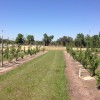 Subtropical peach production includes many practices, such as site selection, orchard design, and disease, weed, and insect management through to harvest. Florida’s subtropical climate allows growers to harvest their crops early, but it creates challenges for the long postharvest growing season. This 14-page fact sheet covers the breadth of topics related to subtropical peach production, including a monthly timeline of recommended practices. Written by M. Olmstead, J. Chaparro, J. G. Williamson, R. Rouse, R. Mizell, P. Harmon, and J. Ferguson, and published by the UF Department of Horticultural Sciences, August 2013.
Subtropical peach production includes many practices, such as site selection, orchard design, and disease, weed, and insect management through to harvest. Florida’s subtropical climate allows growers to harvest their crops early, but it creates challenges for the long postharvest growing season. This 14-page fact sheet covers the breadth of topics related to subtropical peach production, including a monthly timeline of recommended practices. Written by M. Olmstead, J. Chaparro, J. G. Williamson, R. Rouse, R. Mizell, P. Harmon, and J. Ferguson, and published by the UF Department of Horticultural Sciences, August 2013.
http://edis.ifas.ufl.edu/hs348
Florida Peach and Nectarine Varieties
 The University of Florida has developed high-quality, low-chilling, early-maturing peach and nectarine cultivars that can be grown from the panhandle of Florida to as far south as Immokalee. Low-chilling cultivars can grow and produce fruit under Florida conditions that are much warmer in winter than in northern states. Furthermore, ripening of these cultivars during April and May ensures an early spring market window for tree-ripe fresh fruit in Florida before peaches and nectarines from other southeastern states and California come to market. Both commercial and dooryard recommended varieties span the growing season. This 8-page fact sheet was written by Mercy Olmstead, Jose Chaparro, Pete Andersen, Jeff Williamson, and James Ferguson, and published by the UF Department of Horticultural Sciences, May 2013.
The University of Florida has developed high-quality, low-chilling, early-maturing peach and nectarine cultivars that can be grown from the panhandle of Florida to as far south as Immokalee. Low-chilling cultivars can grow and produce fruit under Florida conditions that are much warmer in winter than in northern states. Furthermore, ripening of these cultivars during April and May ensures an early spring market window for tree-ripe fresh fruit in Florida before peaches and nectarines from other southeastern states and California come to market. Both commercial and dooryard recommended varieties span the growing season. This 8-page fact sheet was written by Mercy Olmstead, Jose Chaparro, Pete Andersen, Jeff Williamson, and James Ferguson, and published by the UF Department of Horticultural Sciences, May 2013.
http://edis.ifas.ufl.edu/mg374
2013 Florida Blueberry Integrated Pest Management Guide (HS1156/HS380)
 Recommendations are based on information from the manufacturer’s label and performance data from research and Extension field tests. This 31-page pest management guide was adapted for Florida by Jeffrey G. Williamson, Philip F. Harmon, Oscar E. Liburd, and Peter Dittmar, from the Southeast Regional Blueberry Integrated Management Guide, and published by the UF Department of Horticultural Sciences, November 2012.
Recommendations are based on information from the manufacturer’s label and performance data from research and Extension field tests. This 31-page pest management guide was adapted for Florida by Jeffrey G. Williamson, Philip F. Harmon, Oscar E. Liburd, and Peter Dittmar, from the Southeast Regional Blueberry Integrated Management Guide, and published by the UF Department of Horticultural Sciences, November 2012.
http://edis.ifas.ufl.edu/hs380
How to Calculate Fertigation Injection Rates for Commercial Blueberry Production (HS1197)
 To increase nutrient and water use efficiencies and reduce nutrient leaching and environmental concerns, fertigation is recommended for commercial blueberry production. In fact, successful fertigation can enhance sustainability and maximize profitability for commercial blueberry enterprises. One of the key factors in fertigation is the correct calculation of fertilizer injection rate and time for the acreage. This publication helps blueberry growers correctly calculate fertigation injection rates and times and provides reference tables for checking injection rates and times needed for a variety of production scenarios. This 3-page fact sheet was written by Guodong Liu, Jeffrey Williamson, Gary England, and Alicia Whidden, and published by the UF Department of Horticultural Sciences, March 2012.
To increase nutrient and water use efficiencies and reduce nutrient leaching and environmental concerns, fertigation is recommended for commercial blueberry production. In fact, successful fertigation can enhance sustainability and maximize profitability for commercial blueberry enterprises. One of the key factors in fertigation is the correct calculation of fertilizer injection rate and time for the acreage. This publication helps blueberry growers correctly calculate fertigation injection rates and times and provides reference tables for checking injection rates and times needed for a variety of production scenarios. This 3-page fact sheet was written by Guodong Liu, Jeffrey Williamson, Gary England, and Alicia Whidden, and published by the UF Department of Horticultural Sciences, March 2012.
http://edis.ifas.ufl.edu/hs1197
Weed Management in Pecan (HS95/WG022)
 Weeds compete with pecan trees for light, nutrients, and water. Weed interference can be minimized with proper cultural practices and herbicides. This 5-page fact sheet was written by Peter J. Dittmar and Jeffrey G. Williamson, and published by the UF Department of Horticultural Sciences, March 2012.
Weeds compete with pecan trees for light, nutrients, and water. Weed interference can be minimized with proper cultural practices and herbicides. This 5-page fact sheet was written by Peter J. Dittmar and Jeffrey G. Williamson, and published by the UF Department of Horticultural Sciences, March 2012.
http://edis.ifas.ufl.edu/wg022
Reproductive Growth and Development of Blueberry (HS976/HS220)
 This 7-page fact sheet discusses flower bud initiation and development, pollination and fruit set, fruit development and yeild, and the use of plant growth regulators. Written by J. G. Williamson, J. W. Olmstead, and P. M. Lyrene, and published by the UF Department of Horticultural Sciences, February 2012.
This 7-page fact sheet discusses flower bud initiation and development, pollination and fruit set, fruit development and yeild, and the use of plant growth regulators. Written by J. G. Williamson, J. W. Olmstead, and P. M. Lyrene, and published by the UF Department of Horticultural Sciences, February 2012.
http://edis.ifas.ufl.edu/hs220
Weed Management Guides: Blueberry, Nectarine, and Plum
These 6-page fact sheets were written by Peter J. Dittmar and Jeffrey G. Williamson, and published by the UF Department of Horticultural Sciences, February 2012.
Florida’s Commercial Blueberry Industry (HS742/AC031)
 The Florida blueberry industry has grown rapidly because Florida growers can produce high-quality fruit when few fresh berries are available and berry prices are high. Although southern highbush blueberry acreage has expanded significantly in Florida, Georgia, California, and Mexico during the last several years, better cultivars and improved cultural practices have increased grower production efficiency during the last several years, with promising production trends for the future profitability. This 4-page fact sheet was written by J. G. Williamson, J. W. Olmstead, and P. M. Lyrene, and published by the UF Department of Horticultural Sciences, February 2012.
The Florida blueberry industry has grown rapidly because Florida growers can produce high-quality fruit when few fresh berries are available and berry prices are high. Although southern highbush blueberry acreage has expanded significantly in Florida, Georgia, California, and Mexico during the last several years, better cultivars and improved cultural practices have increased grower production efficiency during the last several years, with promising production trends for the future profitability. This 4-page fact sheet was written by J. G. Williamson, J. W. Olmstead, and P. M. Lyrene, and published by the UF Department of Horticultural Sciences, February 2012.
http://edis.ifas.ufl.edu/ac031
Weed Management in Peach (HS93/WG020)
 Proper weed management is important for a healthy peach orchard. Peach trees and weeds compete for water, nutrients, and light. And they serve as hosts for insects that cause catfacing and nematodes that carry viral diseases. This 6-page fact sheet was written by Peter J. Dittmar and Jeffrey G. Williamson, and published by the UF Department of Horticultural Sciences, January 2012.
Proper weed management is important for a healthy peach orchard. Peach trees and weeds compete for water, nutrients, and light. And they serve as hosts for insects that cause catfacing and nematodes that carry viral diseases. This 6-page fact sheet was written by Peter J. Dittmar and Jeffrey G. Williamson, and published by the UF Department of Horticultural Sciences, January 2012.
http://edis.ifas.ufl.edu/wg020
Protecting Blueberries from Freezes in Florida (HS968/HS216)
 Blueberry growers: know when the conditions are right in commercial blueberry fields, during and after bloom, for freeze damage, as well as practices you can use to minimize it. This 7-page fact sheet was written by J.G. Williamson, P.M. Lyrene, and J.W. Olmstead, and published by the UF Department of Horticultural Sciences, January 2012.
Blueberry growers: know when the conditions are right in commercial blueberry fields, during and after bloom, for freeze damage, as well as practices you can use to minimize it. This 7-page fact sheet was written by J.G. Williamson, P.M. Lyrene, and J.W. Olmstead, and published by the UF Department of Horticultural Sciences, January 2012.
http://edis.ifas.ufl.edu/hs216
Blueberry Gardener’s Guide (CIR1192/MG359)
 Home gardeners: Use this guide to successfully grow blueberries in Florida. This 8-page fact sheet was written by J.G. Williamson, P.M. Lyrene, and J.W. Olmstead, and published by the UF Department of Horticultural Sciences, January 2012.
Home gardeners: Use this guide to successfully grow blueberries in Florida. This 8-page fact sheet was written by J.G. Williamson, P.M. Lyrene, and J.W. Olmstead, and published by the UF Department of Horticultural Sciences, January 2012.
http://edis.ifas.ufl.edu/mg359
